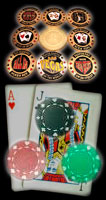Double Bet on the End Games
In some areas of the country, primarily in the South, you’ll find structured games where the bet size doubles on the turn and again the size of the turn bet double that amount.
Typical examples are 3/6/12 or 10/20/40.
On the river, you have a choice between betting $6 or $12 in a 3/6/12 game and $20 or $40 in a 10/20/40 game.
A 10/20/40 game will have two blinds, of $5 and $10, just like a 10/20 game.
The only difference is the larger bet option on the end.
This difference potentially has huge implications for hand value and poker strategy.
The large river bet primarily benefits drawing hands, even with game conditions that aren’t very loose. These are implied-odds games.
There is a perception among many poker writers that the double bet on the end games favors the bad players over the good players.
This isn’t true if you have a reasonable definition of what it means to be a good player.
My definition of a good player is one who can recognize and exploit opportunities.
A double bet on the end game provides many opportunities.
You just have to be good enough to adapt to and exploit them
Pick the Right Table / Picking a Seat / Theories of Poker / Betting Theory: The Odds
A Theory of Starting Hand Value
A Theory of Flop Play: Counting Outs and Evaluating Draws
The Dynamics of Game Conditions / Table Image / Player Stereotypes
Women and Poker / Spread-Limit Games / Kill Games
Short-handed Games / Tournaments / No-limit and Pot-Limit Poker



